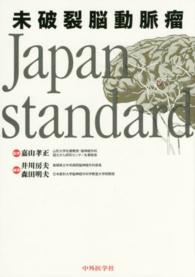- ホーム
- > 洋書
- > 英文書
- > History / World
Full Description
Medieval East Central Europe in a Comparative Perspective draws together the new perspectives concerning the relevance of East Central Europe for current historiography by placing the region in various comparative contexts. The chapters compare conditions within East Central Europe, as well as between East Central Europe, the rest of the continent, and beyond.
Including 15 original chapters from an interdisciplinary team of contributors, this collection begins by posing the question: "What is East Central Europe?" with three specialists offering different interpretations and presenting new conclusions. The book is then grouped into five parts which examine political practice, religion, urban experience, and art and literature. The contributors question and explain the reasons for similarities and differences in governance and strategies for handling allies, enemies or subjects in particular ways. They point out themes and structures from town planning to religious orders that did not function according to political boundaries, and for which the inclusion of East Central European territories was systemic.
The volume offers a new interpretation of medieval East Central Europe, beyond its traditional limits in space and time and beyond the established conceptual schemes. It will be essential reading for students and scholars of medieval East Central Europe.
Contents
Gerhard Jaritz, Introduction
What is East Central Europe?
Nora Berend, The Mirage of East Central Europe: Historical Regions in a Comparative Perspective
Márta Font, The Emergence of East Central Europe and Approaches to Internal Differentiation
Anna Kuznetsova, The Notion of 'Central Europe' in Russian Historical Scholarship
Political Practices
Stefan Burkhardt, Between Empires: South-Eastern Europe and the Two Roman Empires in the Middle Ages
Julia Burkhardt, Negotiating Realms: Political Representation in Late Medieval Poland, Hungary, and the Holy Roman Empire
Religious Space
József Laszlovszky Local Tradition or European Patterns? The Grave of Queen Gertrude in the Pilis Cistercian Abbey
Beatrix F. Romhányi, Mendicant Networks and Population in a European Perspective
Johnny Grandjean Gøgsig Jakobsen, Friars Preachers in Frontier Provinces of Medieval Europe
Urban Space
Olha Kozubska-Andrusiv, Comparable Aspects in Urban Development: Kievan Rus' and the European Middle Ages
Katalin Szende, Town Foundations in East Central Europe and the New World: the Use of the Grid Plan in a Comparative Perspective
Michaela Antonín Malaníková, Female Engagement in Medieval Urban Economy: Late-Medieval Moravia in a Comparative Perspective
Art and Literature
Béla Zsolt Szakács, The Place of East Central Europe on the Map of Romanesque Architecture
Anna Adamska, Intersections: Medieval East Central Europe from the Perspective of Literacy and Communication
Julia Verkholantsev, Etymological Argumentation as a Category of Historiographic Thought in Historical Writings of Bohemia, Poland, and Hungary
János M. Bak, What did we learn? What is to be done? Some insights and visions after reading this book






